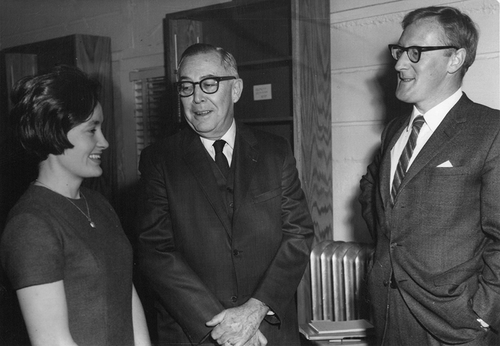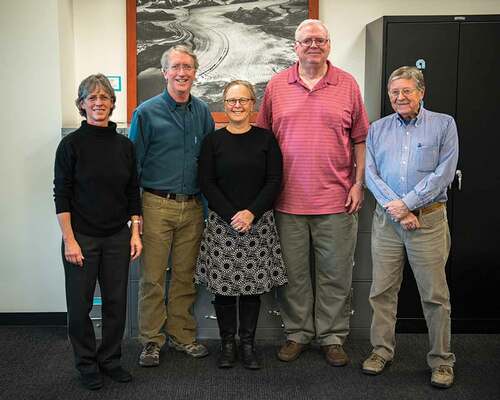The year 2018 marks the 50-year anniversary of Arctic, Antarctic, and Alpine Research (AAAR). During this time period AAAR (formerly Arctic and Alpine Research, AAR) has provided an important outlet for research in cold regions environmental science. AAAR from its inception has been unique for its interdisciplinary nature, publishing papers in a wide diversity of fields including glaciology, geomorphology, paleoceanography, climatology, and ecology.
Fifty years ago (1967–1968), the Institute of Arctic and Alpine Research (INSTAAR), with the University of Colorado, undertook a comprehensive plan for expansion. Emphasizing the multi- and interdisciplinary nature of its research, and complementing its existing field station, the Mountain Research Station, INSTAAR added faculty, new courses of study, and graduate mentoring in the environmental sciences with special regard to arctic and alpine regions. A need for a scientific journal covering cold regions research was recognized, and thus Arctic and Alpine Research was created as a component of INSTAAR’s expansion plan ().
As Director of the Institute, Jack Ives became the Editor of the newly created journal, with Kathleen (Blackie) Salzberg as Managing Editor. The Scientific Advisory Board consisted of Lawrence C. Bliss, Jerry Brown, William S. Osburn, and Lincoln Washburn. The first issue of AAR was published in winter of 1969. Following founder Jack Ives, INSTAAR Directors Patrick Webber, Mark Meier, John Andrews, and James Syvitski served as Editors for the journal. Kathleen Salzberg remained the heart of AAAR as Managing Editor almost 35 years. After 2000, AAAR’s rigorous peer review has been overseen by INSTAAR Fellows Mark Williams, Suzanne Anderson, and current Editors Anne Jennings (2004–present) and William D. Bowman (2007–present). With further expansion of the institute, the journal also grew to encompass all cold regions, including Antarctica and the high-latitude oceans, and to encourage publications from the ever-increasing output from Antarctica, the journal name was changed to Arctic, Antarctic, and Alpine Research. A truly international journal, its published research covers all seven continents by authors from more than 46 countries.
Figure 1. University of Colorado President Joseph Smiley (center) recognizes the establishment in 1969 of INSTAAR’s new journal Arctic and Alpine Research with first Managing Editor Kathleen (Blackie) Salzberg and Institute of Arctic and Alpine Research Director Jack Ives

Papers in AAAR have been critical to better understanding the importance of cold regions to Earth system science, and have been featured in the popular press. Examples include the changing ice balance of mountain glaciers, Mauna Loa’s rapidly melting ice cave, the impacts of trails and roads on tundra or permafrost and their application to environmental management, and multiple anthropogenic influences on ecological processes in cold regions of high latitude and elevation. The importance of a study on alpine plant diversity change with earlier snowmelt was highlighted in Nature, and research on caribou perception of polar bears garnered one group of AAAR authors an Ig Nobel Prize, an award intended to amuse as well as “make people think.” With climate change rapidly altering cold regions environments, including loss of permafrost and ice in mountain glaciers, shrinking sea ice, record drought and fires in Arctic tundra, changes in the carbon stocks of ecosystems, and other significant biological alterations, AAAR will continue to be an important outlet for high-profile research.
After 49 years as an independent journal, AAAR has joined the Taylor & Francis Group’s program of full open access journals. We believe that this partnership will ensure the future health of AAAR and will provide significant opportunities and advancements for readers and authors. All current and archived content of AAR and AAAR will be searchable and freely available on the journal’s new website. Authors will find extensive writing guides, article metrics, social media networking, and manuscript promotion among the added services Taylor & Francis provides.
Shedding its bonds of paper with Volume 50, AAAR will be an online only journal. As before, AAAR will publish one volume per year; however, issues will be eliminated, allowing papers to be published shortly after acceptance. Special issues or topics will be published as virtual collections, and may consist of papers curated from the archive and/or new research. Over the years AAAR has published 31 topical special issues or sections, including “Losing the High Ground: Rapid Transformation of Tropical Island Alpine and Subalpine Environments,” “Changing Cryosphere under a Warming Climate,” “Impacts of the 2008 Volcanic Eruption on the Terrestrial and Nearshore Marine Ecosystems in the Aleutian Islands, Alaska,” and “Arctic-Alpine Ecosystems and People in a Changing Environment.” In 2018 this tradition continues with an extensive interdisciplinary look at research in West Greenland in a special issue edited by Jacob Yde titled “Environmental Change and Impacts in the Kangerlussuaq Area, West Greenland.”
A final note of gratitude goes to Larry Bowlds, the Managing Editor of AAAR since 2004. Through his guidance and command of both the English language and best business practices, Larry worked carefully with authors and editors throughout the copyediting and production process, to uphold the high quality of AAAR and its production, and has kept the journal abreast of rapidly changing publishing trends. Online submission, the addition of its online journal presence to BioOne and JSTOR, and now Taylor & Francis Online Journals, as well as the introduction of open access to AAAR and the creation of the journal’s new look, are some of Larry’s fine accomplishments. Larry retires January 1, 2018, and we hope he will enjoy long into the future, the fruit of his dedicated labor, a successful journal with research accessible to everyone ().
Figure 2. The editorial staff of Arctic, Antarctic, and Alpine Research on the occasion of Larry Bowlds’ retirement after 13 years as Managing Editor. From left to right, Editors Anne Jennings and Bill Bowman, journal assistant Jen Hall-Bowman, Larry Bowlds, and Book Review Editor Wes LeMasurier. (INSTAAR, December 2017)

